How Painful Can Factor Investing Get?
Current vs Past Agonies
August 2019. Reading Time: 10 Minutes. Author: Nicolas Rabener.
SUMMARY
- A classic long-short, multi-factor portfolio has lost close to 20% since 2018
- The drawdown is within expectations, but the recovery period is abnormally long
- However, it’s difficult to argue for structural changes that make factor investing unattractive
SEEKING DIVERSIFICATION THROUGH MULTI-FACTOR PRODUCTS
Investors have flooded into multi-factor strategies over the last several years.
The latest FTSE Russell smart beta study found that 71% of the investors surveyed used such products, up from 49% in 2018. Single factor products were in far less demand. The two most popular – Low Volatility and Value – were used by only 35% and 28% of respondents, respectively.
This is understandable. Since individual factors are as cyclical as equity markets, multi-factor strategies offer diversification benefits and help moderate risk. For example, the Value factor generated negative excess returns in nine out of the last 10 years, constituting a lost decade for Value investors.
Still, while diversifying across factors yields more consistent performance, multi-factor strategies are not immune to significant drawdowns. The last 18 months have not been kind to factor investors, and multi-factor products – with an almost 20% decline – have provided little relief.
So just how painful can factor investing get? Placing the current drawdown in long-short, multi-factor products into historical context offers some insight.
THE CURRENT STATE OF FACTOR INVESTING
With outperformance so elusive in recent years, investors have poured almost $1 trillion into smart beta products – long-only strategies with factor tilts – in hopes of generating alpha. While smart beta differs from the long-short portfolios constructed in factor investing’s foundational academic research, asset managers have launched liquid alternative mutual funds and exchange-traded funds (ETFs) that provide exposure to long-short, multi-factor strategies. Composed of hundreds of global stocks, these long-short, beta-neutral portfolios offer investors access to combinations of factors, Value, Size, Momentum, Low Volatility, and Quality, among them. Though they have short trading histories, these strategies together provide a portrait of factor investing’s recent performance (read Multi-Factor Smart Beta ETFs).
And it isn’t pretty. Since early 2018, most of these products have lost money, with current drawdowns exceeding 20% in some cases. As a consequence, some products have lost more than half of their assets under management (AUM).
Our faith in factor investing is clearly being tested.
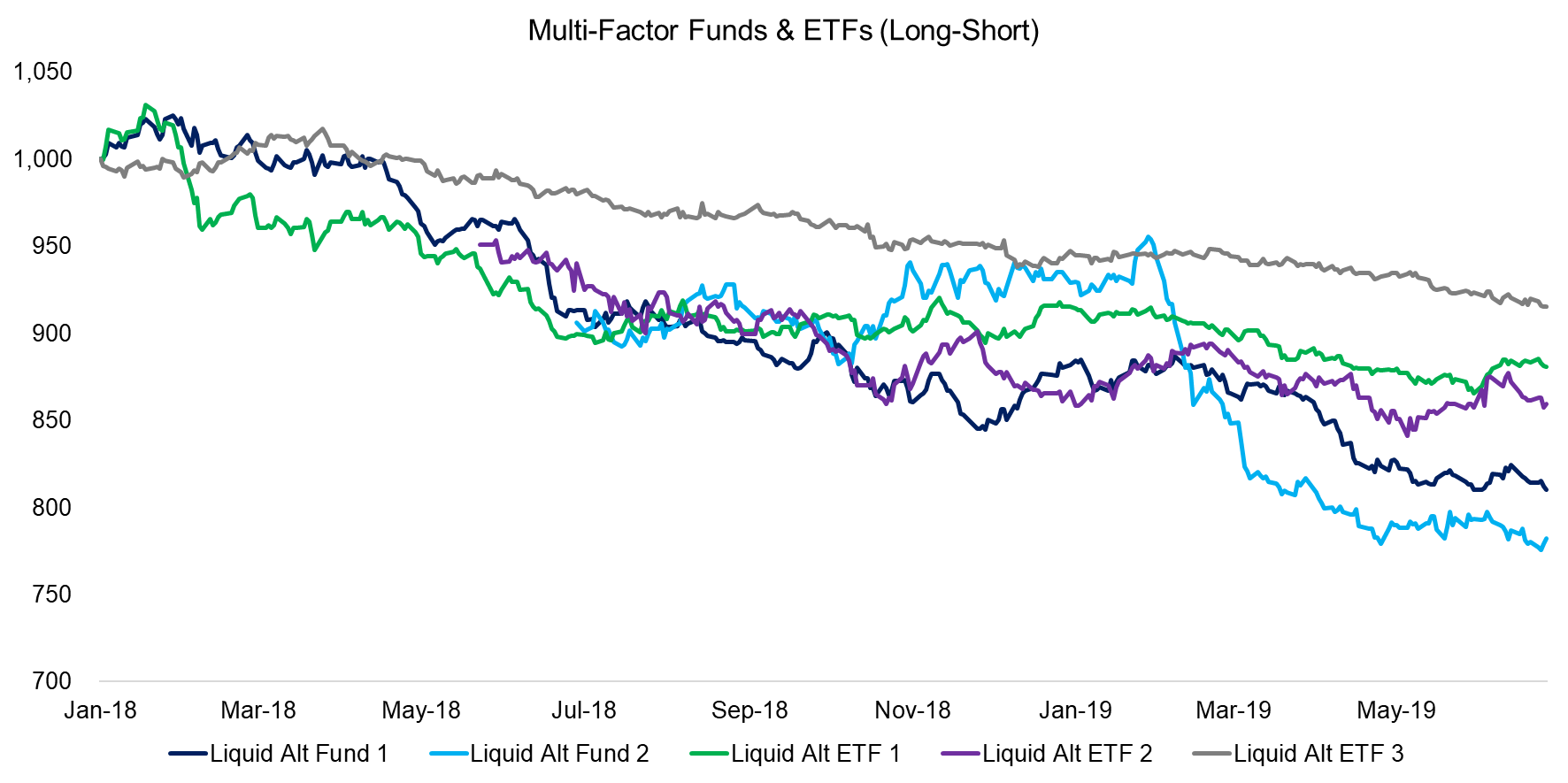
Source: FactorResearch. Fund 2 and ETF 2 have limited trading histories.
FACTOR INVESTING: THE LONG VIEW
So what explains factor investing’s appeal?
To answer that question, we built a simple long-short portfolio based on US stock market data from the Kenneth R. French Data Library, which goes back to 1926. The portfolio allocates equally to the Value, Size, and Momentum factors, which are created by sorting the top and bottom 30% of stocks by factor definition. The long portfolio contains cheap, small, and outperforming stocks, while the short portfolio contains expensive, large, and underperforming ones (read Value, Momentum & Carry Across Asset Classes).
Not counting transaction costs, this multi-factor strategy significantly outperformed the US stock market over the last 90 years. The only challenging periods were during the Great Depression between 1929 and 1939 and over the last 10 years.
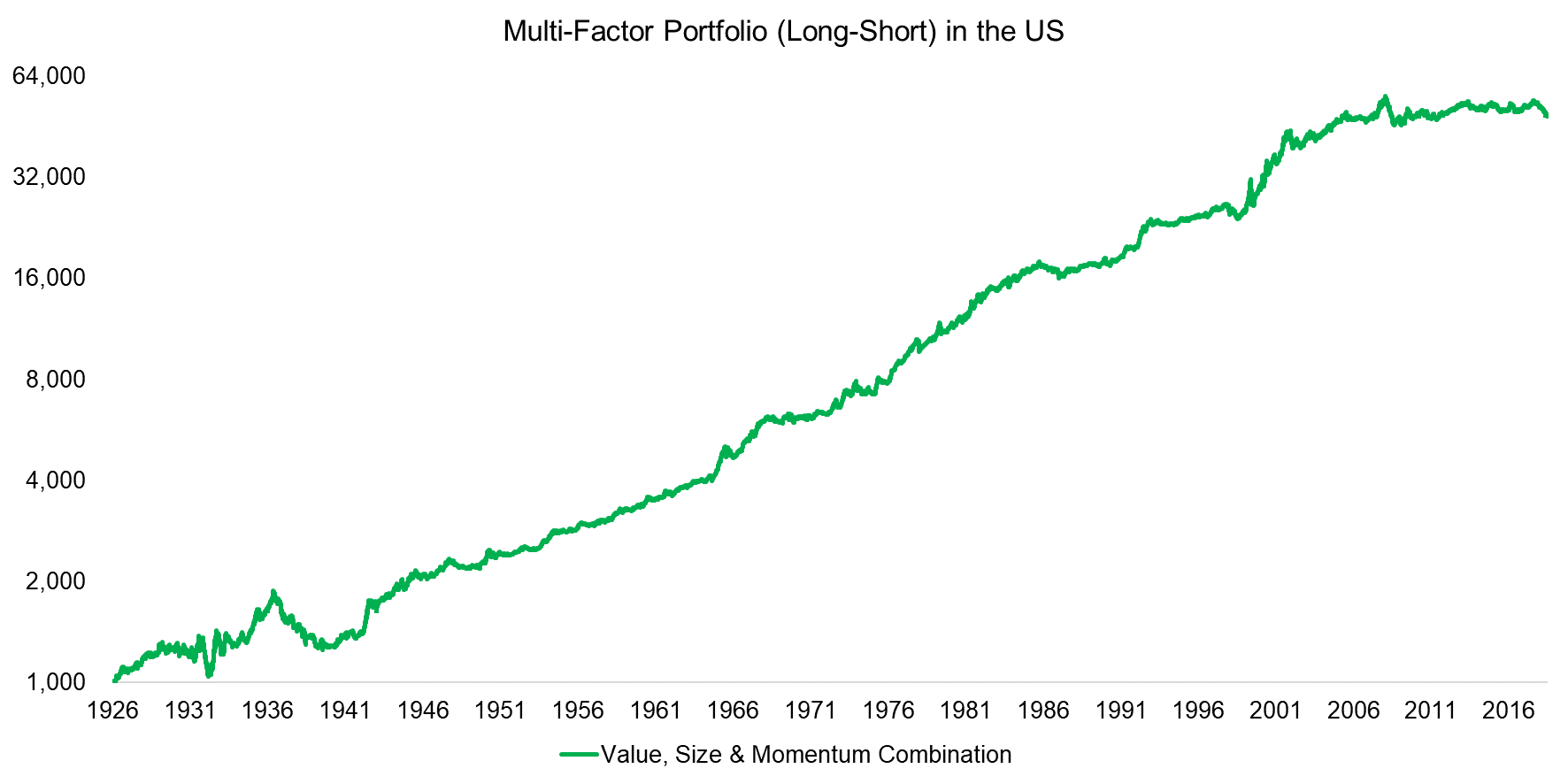
Source: Kenneth R. French Data Library, FactorResearch
LONG-SHORT, MULTI-FACTOR PORTFOLIO DRAWDOWNS
Long-short portfolios are assumed to have less risk than the equity markets as a whole since they’re partially hedged. If the strategy is truly market neutral, with allocations to the short portfolio matching those to the long, then drawdowns should be minimal.
Yet the market-neutral, multi-factor portfolio’s declines have exceeded 30% at times. During the 1939 to 1944 drawdown, all three factors performed poorly and diversification offered little protection. And the current drawdown, which began in 2008 and was fueled largely by the Momentum factor crash during the global financial crisis (GFC), has yet to reclaim its previous peak.
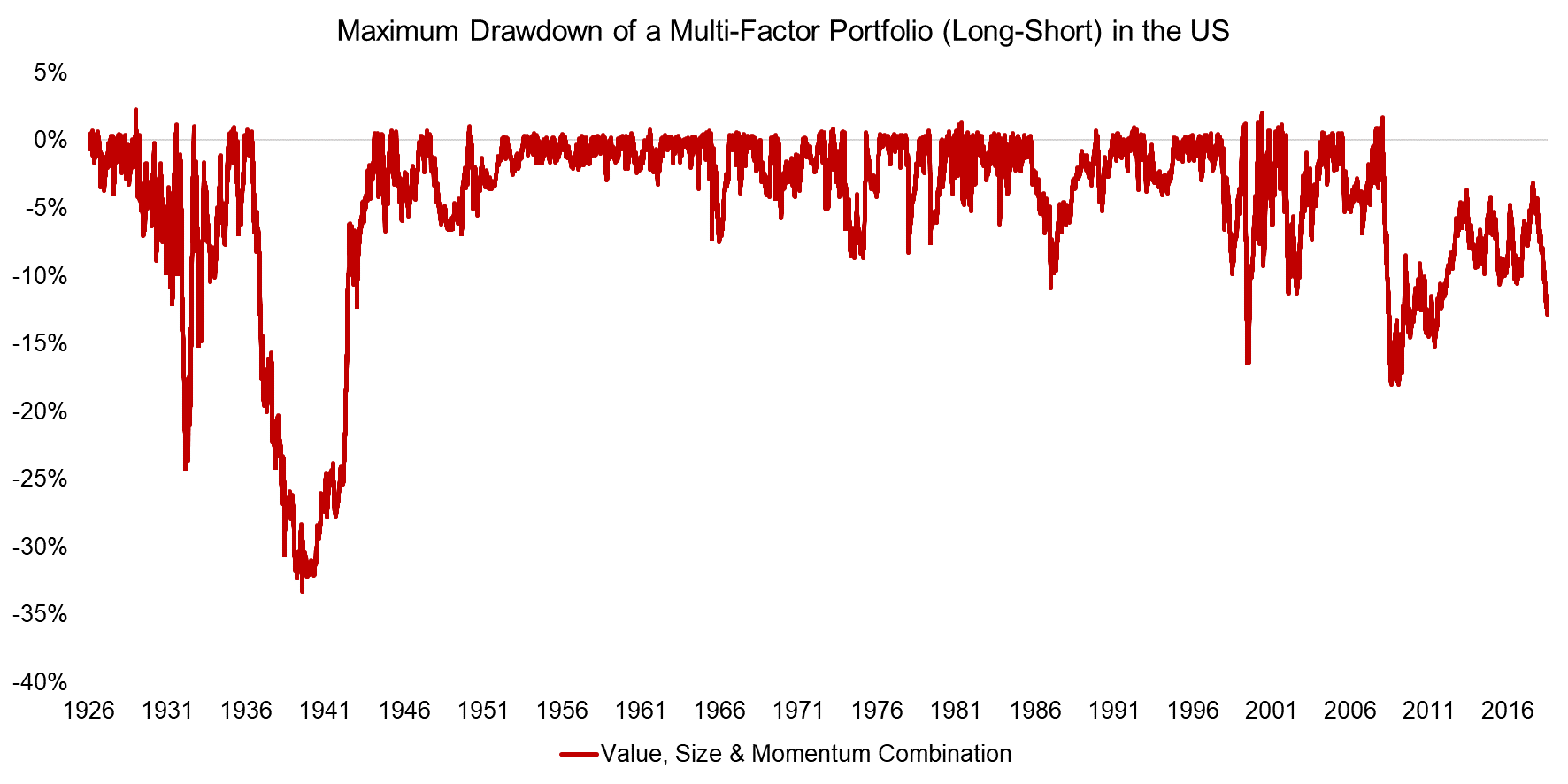
Source: Kenneth R. French Data Library, FactorResearch
Since 1926, drawdowns of 30% or more were rare for long-short, multi-factor portfolios, but smaller declines were fairly common.
Overall the takeaway is clear: Harvesting returns from equity factors is no free lunch and requires as much perseverance as investing in the equity markets.
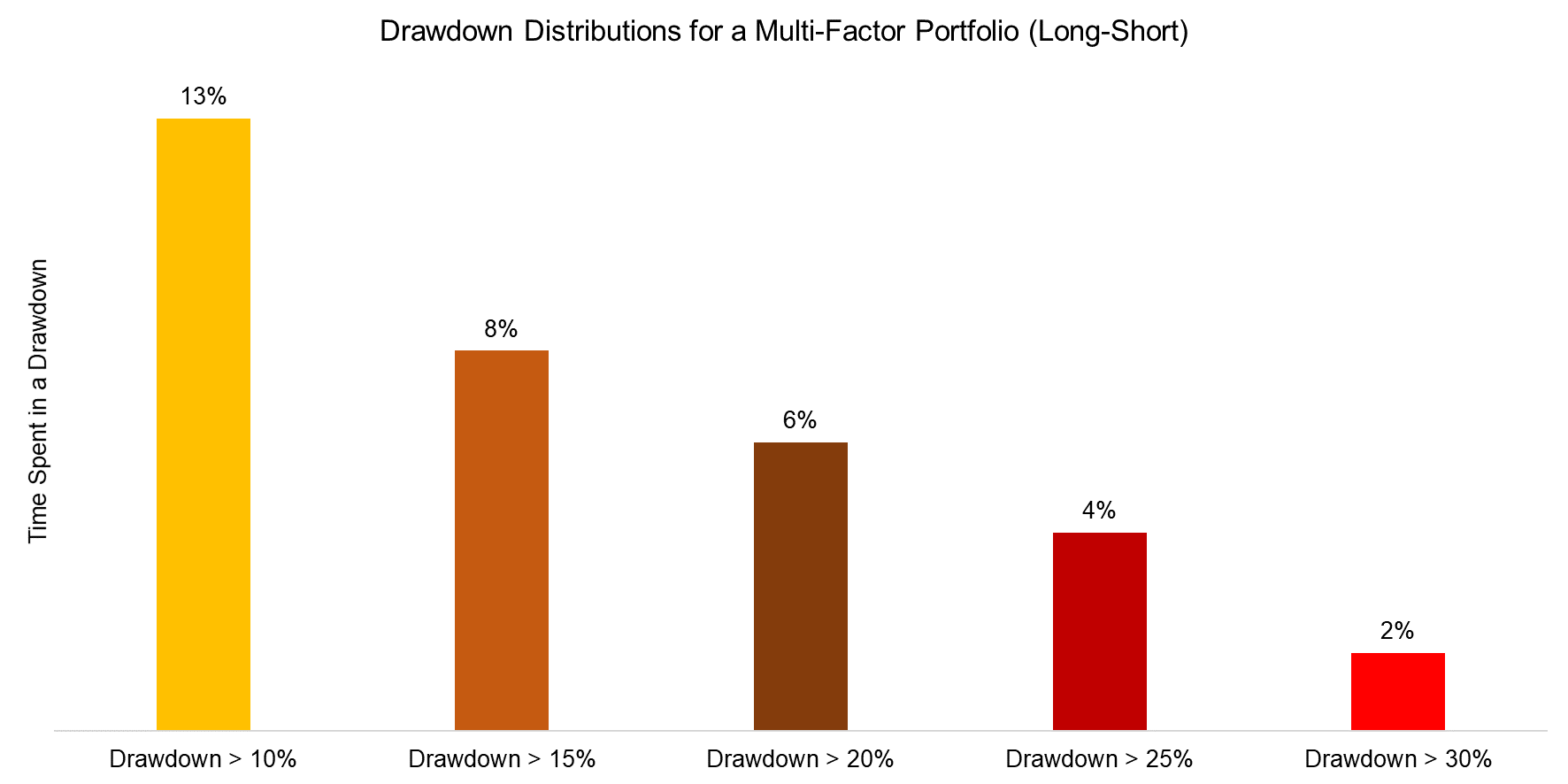
Source: FactorResearch
CURRENT VERSUS HISTORICAL DRAWDOWNS
How does the current, roughly 17% drawdown in the long-short, multi-factor portfolio compare t0 its predecessors? Those from the Great Depression were worse, while that from the tech bubble of 2000 was similar. Nothing here seems out of the ordinary.
Yet the current drawdown is something of an outlier. After more than 10 years, the portfolio has yet to reclaim its previous peak. By comparison, in previous declines, it typically recovered in one to two years.
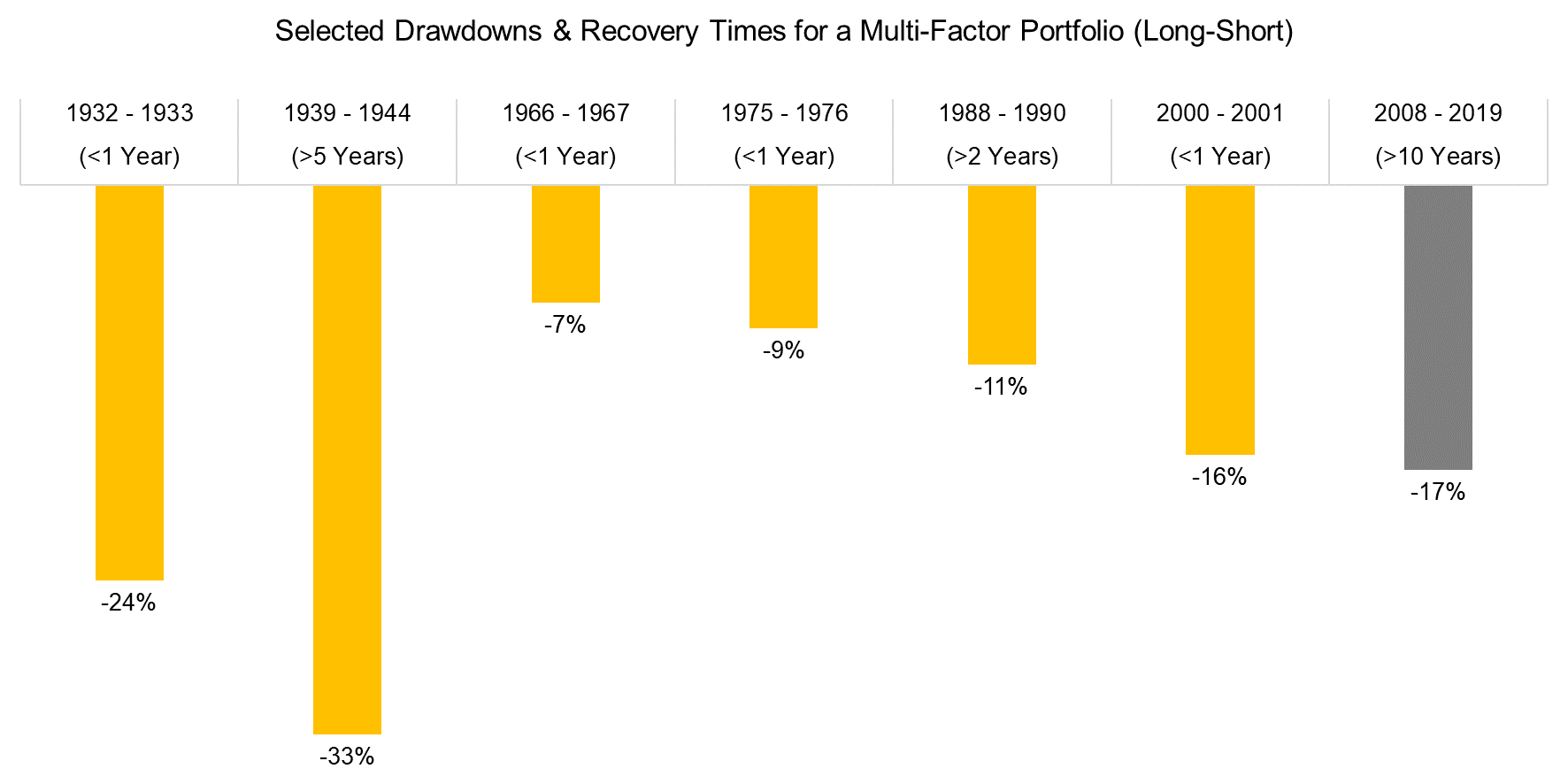
Source: FactorResearch
FURTHER THOUGHTS
What explains the flat performance of our long-short, multi-factor portfolio over the last decade? Could structural changes be responsible? Ten years is a long time to wait. Does factor investing require a perspective beyond most investors’ horizons?
Here are a few things to keep in mind in addressing these questions and factor investing’s recent challenges:
- Flat or declining performance is not an anomaly, though the current 10-year drawdown is overlong by historical standards. However, history is only a proxy, not a rulebook.
- Momentum crashes are rare, occurring only twice in the past 90 years. So the last decade is unusual in that regard.
- Could large inflows into smart beta ETFs and other factor-focused products have eroded factor returns? Measuring valuation spreads – the difference between the long and short portfolio as measured in multiples – can tell us whether factors are trading at high or low cost. But the data does not indicate that structural changes have made all factors more expensive.
- While there have been massive inflows into smart beta, the reallocation from mutual funds to ETFs tracking the S&P 500, among other market cap-weighted indices, has been much larger. This negatively impacts the Size factor, for example, since stocks with large market caps are overweighted. The popularity of ETFs likewise exacerbates the underperformance of certain factors.
- The Momentum and Value factor generated poor returns since 2000 and 2009, respectively, but other factors, Low Volatility, among them, have done well over the last two decades.
- Most factors are derived from behavioral biases, and nothing suggests that investors have left their human nature behind.
Given all this, there is little to suggest that factor investing has structurally changed or that it has lost its appeal. While the returns have been disappointing of late, we would do well to keep on ploughing the fields and wait for better harvests in the future.
RELATED RESEARCH
ABOUT THE AUTHOR
Nicolas Rabener is the CEO & Founder of Finominal, which empowers professional investors with data, technology, and research insights to improve their investment outcomes. Previously he created Jackdaw Capital, an award-winning quantitative hedge fund. Before that Nicolas worked at GIC and Citigroup in London and New York. Nicolas holds a Master of Finance from HHL Leipzig Graduate School of Management, is a CAIA charter holder, and enjoys endurance sports (Ironman & 100km Ultramarathon).
Connect with me on LinkedIn or X.

